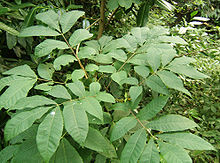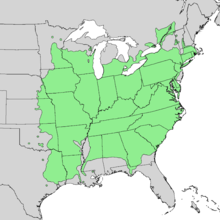Carya cordiformis: bitternut hickory
Observed Ecoregions:
Native Ecoregions:
Freshwater Ecoregions:
Source: Wikipedia
| Bitternut hickory | |
|---|---|
 | |
| Bitternut hickory foliage | |
| Scientific classification | |
| Kingdom: | Plantae |
| Clade: | Tracheophytes |
| Clade: | Angiosperms |
| Clade: | Eudicots |
| Clade: | Rosids |
| Order: | Fagales |
| Family: | Juglandaceae |
| Genus: | Carya |
| Section: | Carya sect. Apocarya |
| Species: | C. cordiformis |
| Binomial name | |
| Carya cordiformis | |
 | |
| Natural range | |
Carya cordiformis, the bitternut hickory,[2] also called bitternut, yellowbud hickory, or swamp hickory, is a large hickory species native to the eastern United States and adjacent Canada. Notable for its unique sulphur-yellow buds, it is one of the most widespread hickories and is the northernmost species of pecan hickory (Carya sect. Apocarya). It is the shortest-lived of the hickories, living to about 200 years.[3]
Description
It is a large deciduous tree, growing up to 35 m (115 ft) tall (exceptionally to 47 m or 154 ft), with a trunk up to 1 m (3 ft 3 in) diameter. The leaves are 15–30 cm (6–12 in) long, pinnate, with 7–11 leaflets, each leaflet lanceolate, 7–13 cm (2+3⁄4–5 in) long, with the apical leaflets the largest but only slightly so. The flowers are small wind-pollinated catkins, produced in spring. The fruit is a very bitter nut, 2–3 cm (3⁄4–1+1⁄4 in) long with a green four-valved cover which splits off at maturity in the fall, and a hard, bony shell. Another identifying characteristic is its bright sulfur-yellow winter bud.
It is closely related to the pecan, sharing similar leaf shape and being classified in the same section of the genus Carya sect. Apocarya, but unlike the pecan, it does not have edible nuts. It is most readily distinguished from the pecan by the smaller number of leaflets, with many leaves having only 7 leaflets (rarely fewer than 9, and often 11–13, in the pecan). Hybrids with the pecan are known, and named Carya × brownii. A hybrid between the shagbark hickory (C. ovata) is also recognized, and is known as Laney's hickory (Carya ×laneyi).[4]
Habitat
Bitternut hickory grows in moist mountain valleys along streambanks and in swamps. Although it is usually found on wet bottom lands, it grows on dry sites and also grows well on poor soils low in nutrients. The species is not included as a titled species in the Society of American Foresters forest cover types because it does not grow in sufficient numbers.
Range
Bitternut hickory grows throughout the eastern United States from southwestern New Hampshire, Vermont, Maine, and southern Quebec; west to southern Ontario, central Michigan, and northern Minnesota; south to eastern Texas; and east to northwestern Florida and Georgia. It is most common, however, from southern New England west to Iowa and from southern Michigan south to Kentucky. It is probably the most abundant and most uniformly distributed of all the hickories. It is most commonly found in the Southern Appalachian Mountains, in high elevations.[5]
Uses
Bitternut is used for lumber and pulpwood. Commercial stands are located mostly north of the other pecan hickories. Bitternut hickory is cut and sold in mixture with the "true" hickories. Because bitternut hickory wood is hard and durable, it is used for furniture, paneling, dowels, tool handles and ladders. Like other hickories, the wood is used for smoking meat, and by Native Americans for making bows. Bitternut hickory seeds are eaten by rabbits,[6] and both its seeds and bark are eaten by other wildlife.
The tannins which give the nuts of bitternut hickory their bitter flavour are not fat soluble. As a result, it is possible to extract an edible oil from the nuts through pressing and separating the tannin containing pulp from the oil.[7] Reportedly, the oil content of bitternut hickories reaches as high as 80%.[8] The oil of bitternut hickory is reputed to have a mild and pleasant flavour, similar to that of pecan oil.[7]
Genetics
Bitternut hickory is a diploid species with two sets of sixteen chromosomes that readily hybridizes with other diploid hickory species with a few named hican varieties available. The pecan variety 'Major' has bitternut alleles at two simple sequence repeat loci indicating a cryptic cross that may also have involved C. ovata.
Gallery
References
- ↑ Stritch, L. (2018). "Carya cordiformis". IUCN Red List of Threatened Species. 2018: e.T62019598A62019600. doi:10.2305/IUCN.UK.2018-1.RLTS.T62019598A62019600.en. Retrieved 19 November 2021.
- ↑ NRCS. "Carya cordiformis". PLANTS Database. United States Department of Agriculture (USDA). Retrieved 1 October 2016.
- ↑ Smith, H. Clay (1990). "Carya cordiformis". In Burns, Russell M.; Honkala, Barbara H. (eds.). Hardwoods. Silvics of North America. Vol. 2. Washington, D.C.: United States Forest Service (USFS), United States Department of Agriculture (USDA). Retrieved 14 December 2009 – via Southern Research Station.
- ↑ "Carya cordiformis X Carya ovata". Archived from the original on 2012-03-31.
- ↑ Sargent, C. S. (September 1918). "Notes on North American Trees. II. Carya". Botanical Gazette. 66 (3): 229–258. doi:10.1086/332332. ISSN 0006-8071. S2CID 84479715.
- ↑ Little, Elbert L. (1980). The Audubon Society Field Guide to North American Trees: Eastern Region. New York: Knopf. p. 346. ISBN 0-394-50760-6.
- 1 2 Bergo, Alan (2022-10-13). "Sam Thayer's Bitternut Hickory Nut Oil". Forager | Chef. Retrieved 2024-07-18.
- ↑ "Yellowbud hickory, the olive oil of the North?". Sidenote. 2024-02-25. Retrieved 2024-07-18.
External links
- Carya cordiformis images at the Arnold Arboretum of Harvard University Plant Image Database
- Enzenbacher, Tiffany. "Plant Collecting in the Wisconsin Wilds - Part 2." Arnold Arboretum of Harvard University website, 6 September 2017. Accessed 21 May 2020.
- "Roads, winter, Valley Road, hickories, 1900." Library Featured Images, Arnold Arboretum of Harvard University website, 5 February 2019. Accessed 21 May 2020.
- Media related to Carya cordiformis (category) at Wikimedia Commons
- Data related to Carya cordiformis at Wikispecies
- Carya cordiformis images at bioimages.vanderbilt.edu*
